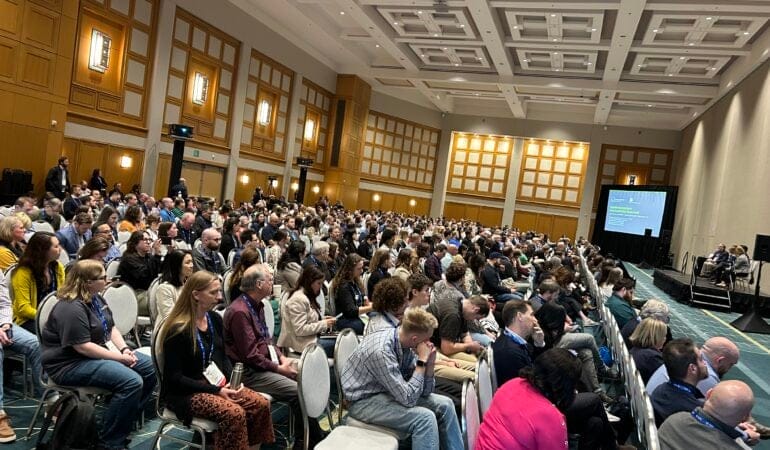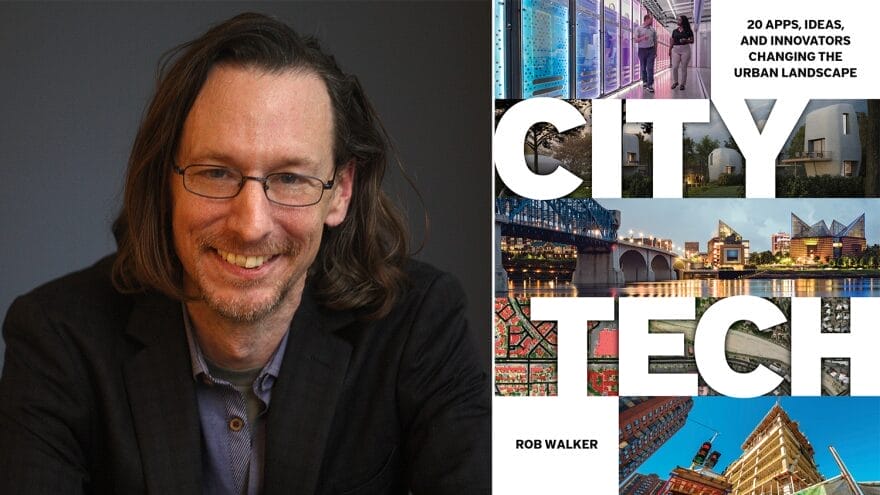Jacob Frey es un nuevo residente sin complejos. Mientras asistía a la facultad de derecho en Villanova, el nativo de Virginia vino a Minneapolis para correr el maratón de Twin Cities y, según lo cuenta, se enamoró de la ciudad. El día después de graduarse, condujo los 1.900 kilómetros al oeste hasta Minneapolis, el lugar que eligió para vivir.
Comenzó como abogado laboral y de derechos civiles, se convirtió en organizador comunitario, ejerció en el consejo de la ciudad y fue electo alcalde en 2017. Bajo este cargo, supervisó la aprobación de una prohibición de zonificación unifamiliar pionera en 2019, enfrentó la COVID y el asesinato policial de George Floyd en 2020. Fue reelecto en 2021 y ha seguido ocupándose de las conexiones entre la equidad racial, la capacidad de pago y la zonificación.
El miembro sénior, Anthony Flint, entrevistó a Frey durante su visita a Minneapolis para la conferencia de la Asociación Estadounidense de Planificación de 2024. Más tarde, Frey se unió a Flint, el alcalde de Cincinnati, Aftab Pureval y la alcaldesa de Scranton Paige Cognetti para un panel de debate con aforo completo sobre las principales antiguas ciudades industriales.
Esta entrevista, que se ha editado por motivos de espacio, puede escucharse completa en el pódcast de Land Matters.
Anthony Flint: Minneapolis ha sido pionera en la reforma de la zonificación y en la prohibición de la zonificación unifamiliar. ¿Cómo le va? ¿Puede hacer algún comentario sobre si aumentar la oferta es un buen camino para lograr la capacidad de pago?
Jacob Frey: Hay dos caminos críticos que se deben tomar en simultáneo para lograr la capacidad de pago. El primero es el subsidio. Es cerrar la brecha entre el precio de mercado y el precio asequible, es asegurarse de que las personas sin vivienda tengan el siguiente peldaño en la escalera para ascender. Ese lado de la ecuación no puede lograrse solo a través de la oferta; requiere cierta intervención del gobierno. Y se necesita oferta para tener un ecosistema de vivienda saludable . . . y así, hace unos 10 años, cuando asumí el cargo de concejal de la ciudad por primera vez, dije con mucha claridad que íbamos a ir a luchar contra los estacionamientos a nivel del suelo. Íbamos a aumentar la oferta y la densidad en gran medida, y eso hicimos. Combinamos eso con un plan integral que, como mencionó, eliminó la zonificación unifamiliar, lo que dio lugar a los dúplex y tríplex en barrios residenciales, y luego también sumó densidad y altura en los corredores comerciales. Todas esas cosas han permitido a Minneapolis mantener los alquileres más bajos que cualquier otra ciudad importante del país. Otras ciudades experimentaron aumentos de dos dígitos, mientras que nuestros aumentos de alquiler se mantuvieron entre el 1 y 2 por ciento. Y esto ocurrió con mucha gente nueva que llegó a la ciudad. Logramos un aumento drástico en la oferta, y ha ayudado mucho.
Durante años, operamos bajo ordenanzas de zonificación prescriptivas que decían explícitamente que mantendríamos a los negros y a los judíos en una parte de la ciudad. Cuando hacer eso explícitamente se volvió ilegal, se comenzó a hacer lo mismo implícitamente a través del código de zonificación, de modo que a menos que uno pudiera ser dueño de una casa enorme en una parcela enorme, no podría vivir en franjas grandes de la ciudad. Las consecuencias de esas decisiones perduran hasta el día de hoy. Queríamos deshacer eso. Buscamos una diversidad de opciones de vivienda en cada barrio y, por lo tanto, una diversidad de personas en cada barrio. En los últimos tres años, hemos construido más de 1.000 unidades de vivienda en edificios multifamiliares en parcelas que antes solo permitían una vivienda unifamiliar.
Hemos visto un gran progreso, . . . y, luego, nos demandaron. A la larga, vamos a ganar, ya sea a través de la legislación o a través del litigio en sí. Todos deberían tener la oportunidad de vivir en una gran ciudad, y queremos crear esa oportunidad para todas las personas.
AF: Para las personas que no están en Minneapolis, ¿quién lo demandó y cuál fue la justificación?
JF: Nos demandó un grupo de personas que dijeron que estábamos haciendo algo que dañaría el medio ambiente, y estoy rotundamente en desacuerdo. Una de las mejores maneras de mejorar el medio ambiente, de reducir tu producción individual de carbono, es vivir en una gran ciudad. En lugar de trasladarte 45 minutos al trabajo desde tu propia casa unifamiliar con cerca de madera en los suburbios o exurbios, puedes caminar hasta la tienda de comestibles e ir en bicicleta al trabajo. Incluso si usas el auto, son menos kilómetros recorridos. La demanda dice, en líneas generales, que deberíamos haber realizado una revisión medioambiental sobre este plan integral y el desarrollo potencial total. Seamos realistas: no podemos asumir que cada edificio del centro tendrá 100 pisos de altura y cada casa unifamiliar será un tríplex, porque eso nunca va a suceder. La forma en que nos pedían que calculáramos el desarrollo no funciona en la realidad.
AF: Pasando ahora al transporte público y la movilidad, ¿cómo está logrando su visión de movilidad sostenible en una metrópolis históricamente dependiente de los automóviles?
JF: Nuestra ciudad se construyó en una época en la que la gente dependía en gran medida de los automóviles. En relación a lo que se construyó antes de ese período de tiempo, las calles y las redes se adaptaron para que se centren en los automóviles. Por supuesto, reconocemos que los automóviles son una forma en que las personas se desplazan, pero queremos agregar opciones para que las personas puedan ir a trabajar en bicicleta de manera segura y cómoda; queremos que los peatones se sientan cómodos y, de hecho, que se les dé prioridad; queremos agregar opciones de transporte público, no solo como una opción que esté disponible de vez en cuando, sino como una opción conveniente para ir del punto A al punto B.
Estamos sumando autobuses de tránsito rápido (BRT, por su sigla en inglés) siempre que sea posible. Observamos un aumento drástico en el número de líneas de BRT y, en los últimos 15 años, Minneapolis ha tenido un crecimiento de alrededor de 50.000 personas; sin embargo, el total de kilómetros recorridos por vehículos y las emisiones de gases han disminuido.
Reconocemos que la gente va a usar automóviles y vamos a tratar de hacer que esos automóviles sean lo más sostenibles posible a través de estaciones de carga de vehículos eléctricos. En este momento, también estamos agregando carriles de tránsito específicos para autobuses para que uno pueda tomar el autobús y evitar el tráfico en el que, de otro modo, estaría atascado.

AF: ¿Cuál es su valoración del financiamiento basado en el suelo para financiar el transporte, la reurbanización, la vivienda asequible y los parques? La idea es que la acción y las inversiones del gobierno creen valor en el suelo y la urbanización privados. ¿No es posible aprovechar una parte de ese aumento de valor y reinvertirlo en la comunidad? ¿Es partidario de la recuperación de plusvalías?
JF: Creo que no es inteligente estar a favor de la recuperación de plusvalías, del financiamiento por incremento impositivo (TIF, por su sigla en inglés), o en contra de la recuperación de plusvalías o del TIF. Es una herramienta muy importante y necesita equilibrarse. Hay una manera de mejorar una ciudad mediante el uso de herramientas como la recuperación de plusvalías y el TIF para lograr estructuras y opciones de construcción y transporte maravillosas que no serían posibles si no fuera por la intervención del gobierno. Lo hemos estado usando de diversas maneras, incluido uno de los movimientos de políticas más populares que hemos hecho en los últimos años, que es derribar el viejo Kmart. Para ponerlo en contexto, unos 40 o 50 años atrás, se tomó la decisión de bloquear Nicollet Avenue y poner un gran Kmart en un enorme estacionamiento en el medio.
Sería algo injusto por mi parte cuestionar las decisiones que se tomaron en ese momento, porque estoy seguro de que, dentro de 40 años, las decisiones que he tomado no serán tan inteligentes, pero, en mi opinión, esta es una de las peores decisiones de planeamiento urbano tomadas en nuestra ciudad. Encontramos formas de obtener el control del suelo sobre ese antiguo Kmart. Vamos a derribar el edificio. Vamos a abrir la calle, y revitalizar esta importante arteria, y asegurarnos de que no falte nada, desde un parque hasta viviendas asequibles, además de precios comerciales y de mercado. Permite que el flujo de emprendimientos y el crecimiento de nuevos negocios en ese corredor se expandan hacia el sur y el norte. Una gran parte de lo que estamos utilizando para lograr este objetivo a gran escala es la recuperación de plusvalías.
Es una herramienta que debe usarse, pero también es una herramienta que no debe usarse cada vez que se levanta un nuevo edificio o aparece una oportunidad nueva. Tiene que haber un equilibrio.
AF: Un grupo de trabajo está estudiando cambios en el Consejo Metropolitano, pero ¿de qué manera está funcionando este acuerdo pionero? ¿Puede o debe ser replicable esta idea de gobernanza regional?
JF: No se puede pensar en ninguna ciudad como si viviera en el vacío. El alcalde Carter [de St. Paul] y yo bromeamos diciendo que no solo protegemos el agua de nuestro lado del río Mississippi; lo compartimos. De la misma forma, compartimos una economía que no termina donde termina la calle y comienza el límite.
Tengo una responsabilidad con la ciudad de Minneapolis, y ayuda tener un órgano de gobierno que tenga un enfoque regional. Tenemos un Concejo Metropolitano nombrado en gran parte por el gobernador que nos ayuda a poner un metro ligero que pasa por varios municipios diferentes. Nos ayuda a diseñar el tránsito rápido de autobuses, ayuda a pagar la policía de tránsito metropolitano. Tener ese enfoque regional no solo es importante, sino que es crucial para promover una mentalidad y un objetivo regionales.
AF: ¿Cuál es su opinión sobre los pasadizos elevados? Las prácticas actuales de planeamiento urbano sugieren un enfoque en la calle y la actividad a nivel de la calle. ¿Existe algún conflicto ahí? Cuéntenos un poco sobre la parte de diseño urbano de su trabajo.
JF: Si tienes 100.000 o 200.000 personas que vienen al centro de la ciudad, y tienes dos niveles de actividad, estás dividiendo el número que sea entre esos dos niveles. ¿Me gusta dividir la actividad? Por supuesto que no. A nadie le gusta. Prefiero tener una concentración de todo ese bullicio, exaltación y movimiento en un solo nivel. Pero uso el pasadizo elevado. Durante los meses que hace frío, entro y me como un sándwich, y no me siento culpable por ello. De hecho, estoy realmente entusiasmado de ver a los propietarios de pequeñas empresas locales que operan en él.
Los pasadizos elevados se han visto particularmente afectados en los últimos años debido a una disminución en el número de trabajadores que vienen al centro cada año. No aceptaré más críticas sobre la falta de movimiento en el centro o el cierre de la tienda de sándwiches favorita de alguien, por parte de la persona que está sentada en el sofá de su casa en los suburbios. Si le importa, entonces debería estar apoyando esa tienda de sándwiches.
Si quieres ver movimiento y quieres ver más tráfico peatonal, tus pies deberían sumarse a ese tráfico. Estamos aumentando los números de manera bastante radical en este momento. La gente sin duda está regresando, pero no está sucediendo de forma explosiva.
AF: Se ha convertido en un cliché, pero en verdad no hay sustituto para estar en la oficina.
JF: Son las interacciones no planificadas las que en última instancia ayudan. Estoy gran parte del tiempo en Minneapolis debido a una coincidencia. Conoces a alguien, consigues un trabajo, obtienes una entrevista, encuentras una gran ciudad de la que te enamoras. Estas cosas solo suceden porque estuviste allí para que te sucedieran.
Anthony Flint es miembro sénior del Instituto Lincoln de Políticas de Suelo, conduce el ciclo de pódcasts Land Matters y es editor colaborador de Land Lines. Es el autor de El escritorio del alcalde: 20 conversaciones con dirigentes locales que resuelven problemas globales.
Imagen principal: El alcalde Jacob Frey. Crédito: Cortesía de la Oficina del Alcalde de Minneapolis.









